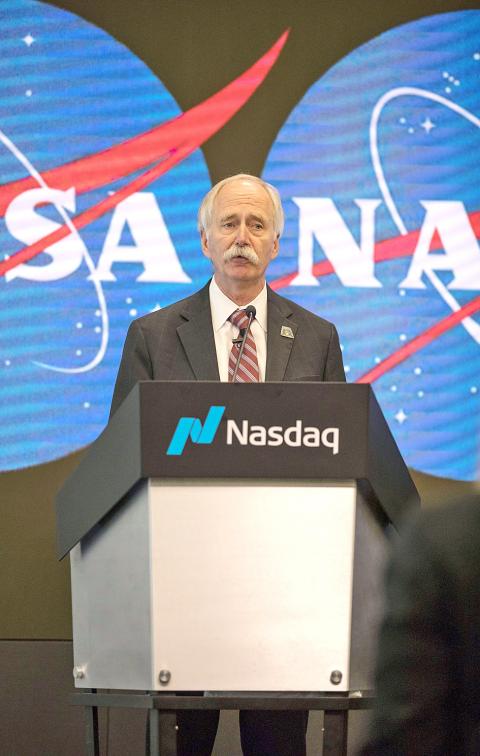NASA on Friday said it would open up the International Space Station (ISS) to business ventures including space tourism, as it seeks to financially disengage from the orbiting research lab.
The price tag? Tens of millions of US dollars for a round trip ticket and US$35,000 a night.
“NASA is opening the International Space Station to commercial opportunities and marketing these opportunities as we’ve never done before,” NASA chief financial officer Jeff DeWit said in an announcement made at the NASDAQ stock exchange in New York.

Photo: AP
There would be up to two short private astronaut missions per year, ISS deputy director Robyn Gatens said.
The missions would be for stays of up to 30 days. As many as a dozen private astronauts could visit the ISS per year, NASA said.
These travelers would be ferried to the orbiter exclusively by the two US companies developing transport vehicles for NASA: Space Exploration Technologies Corp, commonly known as SpaceX, with its Crew Dragon capsule, and Boeing Co, which is building one called Starliner.
These companies would choose the clients — who would not have to be US citizens — and bill for the trip to the ISS, which would be the most expensive part of the adventure: about US$58 million for a round-trip ticket.
That is the average rate the companies would bill NASA for taking the space adventurers up to the ISS.
Neither Dragon nor Starliner are ready. Their transport capsules are supposed to be ready near the end of this year, but the timetable depends on the results of a series of tests, so the private missions would have to wait until next year at the earliest.
The tourists would pay NASA for food and water, as well as their use of the station and the life support system, which would cost about US$35,000 per night per astronaut, DeWit said.
That does not include Internet usage, which would cost US$50 per gigabyte.
The space station does not belong to NASA. It was built with Russia starting in 1998, and other countries participate in the mission and send up astronauts, but the US has paid for and controls most of the modules that make it up.
The new space tourists to the ISS would not be the first: US businessman Dennis Tito had that honor in 2001. He paid Russia about US$20 million for the trip.
Others followed in his footsteps, the last being Cirque du Soleil founder Guy Laliberte in 2009.
Since 2011, Russian Soyuz rockets have been the only way to get to the space station, and they have transported only space agency astronauts, as well as Russian cosmonauts.
There are usually three to six crew members on the ISS at any given time. Right now it is home to three Americans, two Russians and a Canadian.
Russia plans to resume tourist flights in late 2021.
The policy change announced on Friday includes the opening of parts of the ISS to private sector companies for commercial and marketing activity.
This would include start-ups developing techniques for building materials in conditions of weightlessness.
Fiber optic cables, for example, are of extraordinary quality when manufactured in microgravity.
The idea is to develop the space economy in the hope of seeing the private sector take over the ISS, which the US hopes to stop financing near the end of next year.
“We want to be there as a tenant, not as the landlord,” NASA administrator Jim Bridenstine said in April.
The agency wants to free up funds for a return to the moon mission called Artemis in 2024 and for sending the first humans to Mars, perhaps in the 2030s, but it remains unclear if commercial activity in Earth’s orbit is profitable, because it is still so expensive to get up there in the first place.
In the end, NASA appears to have changed its stance to meet its huge budget needs.
When Russia announced it was taking Tito to the space station, NASA was at first opposed to such a mission and ended up sending the Russians a bill for his stay on the ISS.

US sports leagues rushed to get in on the multi-billion US dollar bonanza of legalized betting, but the arrest of an National Basketball Association (NBA) coach and player in two sprawling US federal investigations show the potential cost of partnering with the gambling industry. Portland Trail Blazers coach Chauncey Billups, a former Detroit Pistons star and an NBA Hall of Famer, was arrested for his alleged role in rigged illegal poker games that prosecutors say were tied to Mafia crime families. Miami Heat guard Terry Rozier was charged with manipulating his play for the benefit of bettors and former NBA player and

The DBS Foundation yesterday announced the launch of two flagship programs, “Silver Motion” and “Happier Caregiver, Healthier Seniors,” in partnership with CCILU Ltd, Hondao Senior Citizens’ Welfare Foundation and the Garden of Hope Foundation to help Taiwan face the challenges of a rapidly aging population. The foundation said it would invest S$4.91 million (US$3.8 million) over three years to foster inclusion and resilience in an aging society. “Aging may bring challenges, but it also brings opportunities. With many Asian markets rapidly becoming super-aged, the DBS Foundation is working with a regional ecosystem of like-minded partners across the private, public and people sectors

BREAKTHROUGH TECH: Powertech expects its fan-out PLP system to become mainstream, saying it can offer three-times greater production throughput Chip packaging service provider Powertech Technology Inc (力成科技) plans to more than double its capital expenditures next year to more than NT$40 billion (US$1.31 billion) as demand for its new panel-level packaging (PLP) technology, primarily used in chips for artificial intelligence (AI) applications, has greatly exceeded what it can supply. A significant portion of the budget, about US$1 billion, would be earmarked for fan-out PLP technology, Powertech told investors yesterday. Its heavy investment in fan-out PLP technology over the past 10 years is expected to bear fruit in 2027 after the technology enters volume production, it said, adding that the tech would

YEAR-END BOOST: The holiday shopping season in the US and Europe, combined with rising demand for AI applications, is expected to drive exports to a new high, the NDC said Taiwan’s business climate monitor improved last month, transitioning from steady growth for the first time in five months, as robust global demand for artificial intelligence (AI) products and new iPhone shipments boosted exports and corporate sales, the National Development Council (NDC) said yesterday. The council uses a five-color system to measure the nation’s economic state, with “green” indicating steady growth, “red” suggesting a boom and “blue” reflecting a recession. “Yellow-red” and “yellow-blue” suggest a transition to a stronger or weaker condition. The total score of the monitor’s composite index rose to 35 points from a revised 31 in August, ending a four-month